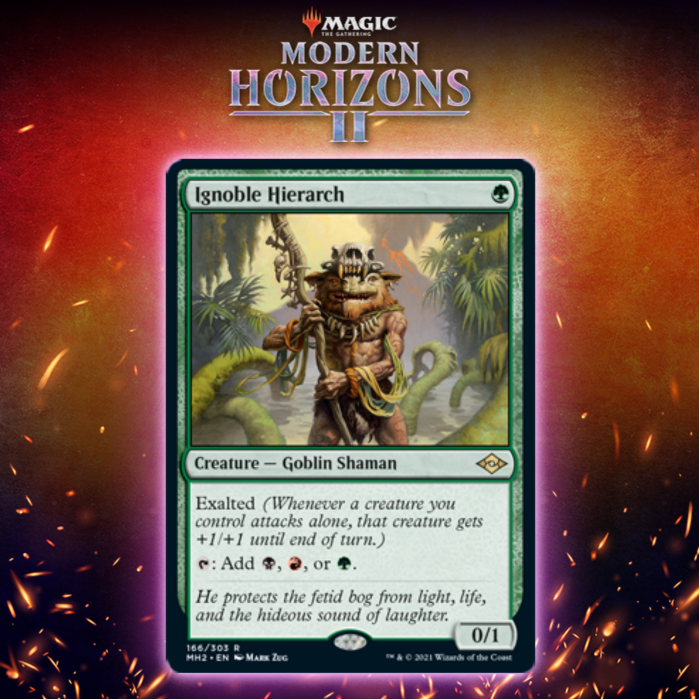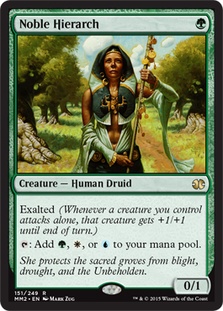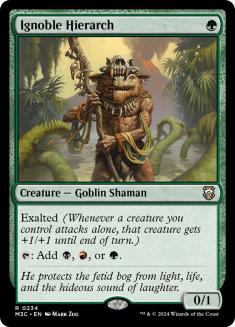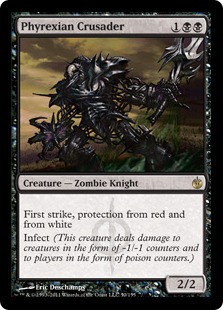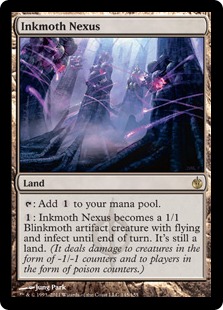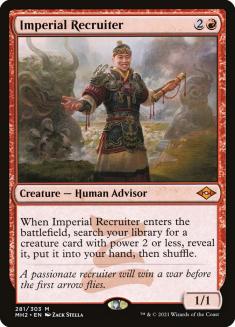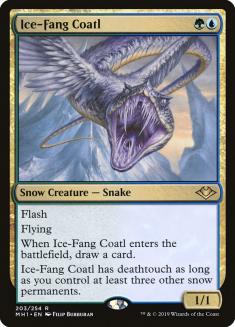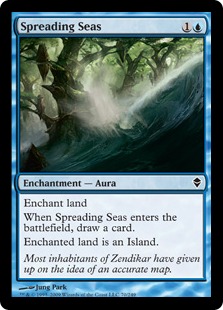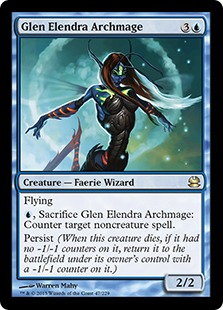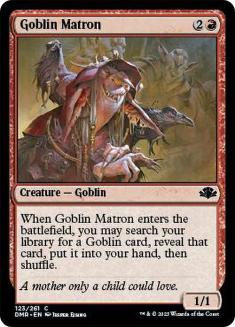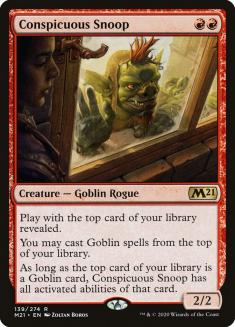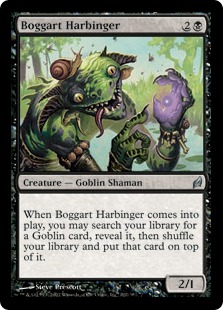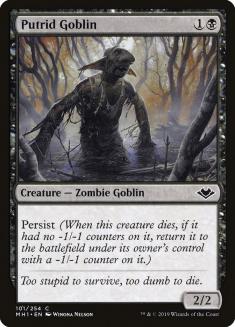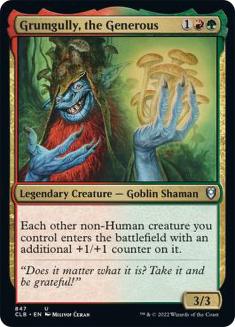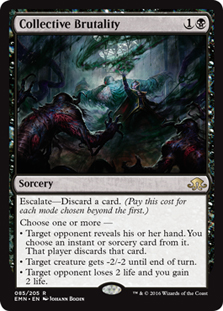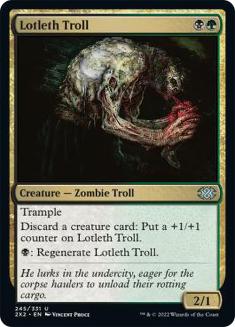I’ve cast a lot of mana creatures in my career. Like… a lot of them. And many of my best finishes have been with decks whose plan was to leverage an early mana advantage. They are staples of every format, and since Modern’s inception, Noble Hierarch has been not only among the format’s best creatures, but its best cards.
So while it was no surprise to see a powerful mana creature in Modern Horizons 2, seeing one on the power level of Noble Hierarch was certainly unexpected:
Leveraging a mana advantage is all about speed, so it’s important for them to cost one. That way you can start accelerating your curve as soon as possible. The downside of mana creatures is how they can lead to flooding. If you’re unable to close the game out quickly, they usually don’t hold their weight in the late-game. However, exalted is a powerful enough mechanic that Noble, and now Ignoble, Hierarch is often still a relevant card in long games.
+1/+1 may not seem like much, and against a goldfish it isn’t. But Magic isn’t played against a goldfish. That extra size often allows you to attack with a creature that otherwise wouldn’t, which means you’re not just getting one extra damage, you’re getting one plus the power of the attacking creature. If exalted enables multiple such attacks, you’re gaining upwards of ten damage.
The power here is undeniable given the pedigree of Noble Hierarch. The original has seen play in countless Modern decks over the years, even ones that had little to no use for its mana fixing. Ignoble Hierarch will unlock archetypes that need the added access to red and black mana, which will be my focus in today’s article. First up is a new (old) look at a classic Modern archetype that has fallen on hard times:
Creatures (14)
Lands (18)
Spells (28)

Golgari Infect emerged years ago in the days before Fatal Push, when Modern removal suites were dominated by Lightning Bolt and Path to Exile. That metagame was ripe for Phyrexian Crusader to dominate, and was enough to draw some players away from blue. However, the combination Noble Hierarch not making black mana, the need for a low land count, and Inkmoth Nexus adding several colorless lands to the mana base meant that casting Phyrexian Crusader was far from a given.
The deck’s mana base was much worse than Simic Infect, and could struggle against heavy creature decks since Blighted Agent is an important threat to get through blockers. It never caught on heavily and the printing of Fatal Push made Phyrexian Crusader much easier to answer, so Golgari Infect faded to obscurity.
But these days, Simic Infect is struggling in a world where Lava Dart, Wrenn and Six, and Teferi, Time Raveler are all major headaches and ubiquitous in the metagame. Phyrexian Crusader once again looks to be a savior for the archetype, especially in the Izzet Prowess matchups where it’s an absolute monster. Kozilek’s Return may be a common sideboard answer, but it’s incredibly unreliable in the face of Mutagenic Growth and other pump spells.
Ignoble Hierarch now makes Phyrexian Crusader more reliable to cast, which is a huge upgrade, but there are other benefits to going black. Abrupt Decay is a great answer to problematic cards like Chalice of the Void and Wrenn and Six, and there’s plenty of good interactive cards for the sideboard, though you should be careful not to bring too many of them in and strip away too much of the deck’s core gameplan. Last is the Call of the Death-Dweller in the sideboard, which should perform very well against heavy-interaction decks, either returning some combination of cheap creatures or a Phyrexian Crusader, which is an absolute wrecking ball with deathtouch and menace.
I also included a single copy of Yavimaya, Cradle of Growth in the mana base, which I expect to become a staple of all Infect decks. Inkmoth Nexus is a great card, but it can really muck up your mana base when you’re trying to cast a bunch of green spells in one turn. Yavimaya is a low cost way of mitigating that problem, and I value it highly enough to cut a Pendelhaven to make room.
The pump spell suite is mostly unchanged from current Simic builds, but I’ve included one copy of Rancor in both the maindeck and the sideboard to help the deck go over the top of blockers. It comes at the cost of another protection spell, which shouldn’t be as necessary with Phyrexian Crusader being so resilient to removal.
The Return of Kiki-Chord
Next up is another new spin on an old archetype, this time taking advantage of the red mana from Ignoble Hierarch to cast Kiki-Jiki, Mirror Breaker. Kiki-Chord decks were popular years ago in Modern, but they eventually evolved into more of a fair deck because Kiki-Jiki was so difficult to cast that you couldn’t play many copies. That made the combo less consistent, so the deck needed to pivot into more of a traditional midrange strategy.
That strategy was eventually pushed to the fringe as the format grew in power. You really need that combo to keep up with the rest of the format, and now you have the ability to lean further into that gameplan.
Creatures (41)
- 4 Birds of Paradise
- 3 Kiki-Jiki, Mirror Breaker
- 1 Eternal Witness
- 4 Imperial Recruiter
- 2 Wall of Roots
- 1 Magus of the Moon
- 1 Venser, Shaper Savant
- 1 Glen Elendra Archmage
- 1 Spellskite
- 4 Deceiver Exarch
- 1 Scavenging Ooze
- 1 Phantasmal Image
- 1 Huntmaster of the Fells
- 1 Reclamation Sage
- 1 Pia and Kiran Nalaar
- 4 Ice-Fang Coatl
- 4 Seasoned Pyromancer
- 1 Klothys, God of Destiny
- 1 Yorion, Sky Nomad
- 4 Ignoble Hierarch
Planeswalkers (2)
Lands (29)
Spells (8)
Sideboard

Normally I’d be worried about adding twenty cards to a combo deck in order to utilize Yorion, Sky Nomad as a companion, but it’s a huge boon to the deck’s fair gameplan, and the addition of Imperial Recruiter from Modern Horizons 2 makes assembling the combo much easier. You now have eight clean tutors for nearly your entire deck, so an effective twelve copies of Deceiver Exarch and eleven of Kiki-Jiki.
The additional deck space also makes it easier to fill out the deck’s toolbox without disrupting your draws too often. I may have gone a bit overboard with tutor targets, but most of them are solid individual cards and Seasoned Pyromancer makes it easy to rummage them away when they aren’t needed. That rummaging also helps effectively thin the deck, letting you assemble the combo reliably.
It feels strange not playing white in a deck that’s trying to take advantage of blink synergies, but I like what blue brings. Ice-Fang Coatl is a cantrip for Yorion as well as a way to interact with big creatures, which is the main issue from having only red cards for removal. Spreading Seas in the sideboard are excellent against big mana matchups, which are difficult, and Glen Elendra Archmage is a phenomenal tutor target against control. There isn’t a lot of blue in this deck, but it certainly pulls its weight.
Much like Golgari Infect, this deck gains a ton in terms of consistency from Ignoble Hierarch. Now it can lean into a Gruul base with blue as a splash color, and threaten to cast Kiki-Jiki as a finisher or even just a value engine if you don’t have a Deceiver Exarch. You have enough interaction between Lightning Bolt, Wrenn and Six, and silver bullets as well as the card advantage to win a fair game, but make sure you leverage the threat of the combo to keep your opponent off balance.
Not Just For Humans Anymore
Noble Hierarch’s most successful home has been in Humans, which is somewhat strange given the curve of that deck stops at three, but that’s the power of the card. Interestingly, Ignoble Hierarch is a Goblin, not a Human. Goblins has made some noise in Modern since the first Modern Horizons set brought Goblin Matron to the format and Conspicuous Snoop gave the tribe a potential two-card combo with Boggart Harbinger.
However, Goblins has always been a mana hungry tribe and it quickly became clear how dependent the deck was on Aether Vial to deploy its cards in a timely manner. Ignoble Hierarch is a great complement to Aether Vial, and much like in Humans, Cavern of Souls makes paying another color much easier in a tribal deck.
Creatures (36)
- 4 Goblin Matron
- 2 Kiki-Jiki, Mirror Breaker
- 1 Goblin Ringleader
- 3 Skirk Prospector
- 4 Imperial Recruiter
- 4 Boggart Harbinger
- 1 Murderous Redcap
- 1 Metallic Mimic
- 1 Munitions Expert
- 4 Putrid Goblin
- 3 Grumgully, the Generous
- 4 Conspicuous Snoop
- 4 Ignoble Hierarch
Lands (18)
Spells (6)

I haven’t been impressed by the fair game that Goblins has, so I’m leaning hard into the combo. Not only do you have Conspicuous Snoop and Boggart Harbinger, I’m also including Putrid Goblin and Grumgully, the Generous, which will make as much red mana as you want with Skirk Prospector and kill your opponent with Murderous Redcap.
Goblin Matron and Imperial Recruiter help you assemble either combo, since each card can find any piece of either combo. Recruiter may not find Grumgully itself, but the singleton Metallic Mimic on Goblin will do just fine as a substitute. With only 60 cards and two combos to flesh out, there isn’t much room for a toolbox, so I limited it to just a Munitions Expert to answer problematic creatures like Plague Engineer and a Goblin Ringleader in case things have gone poorly and you need to rebuild from scratch.
The sideboard has a couple more answers to tutor for as well as the rest of the Ringleaders to bring in against midrange and control strategies. But this deck is about as all-in as it gets when it comes to combo. I like to commit to a combo when the pieces are creatures, since your ability to get scrappy with a pile of 1/1s offers a built-in resilience, even if it isn’t pretty.
When sideboarding with this deck, you’ll want to pick just one combo to leave completely intact, and strip down to bare bones of the other one in order to fit in whatever interaction is necessary for the matchup. Whichever combo you choose to leave in will likely be based on the matchup, your opponent’s sideboard should you know it, and their approach to the matchup, but don’t be afraid to switch things up between Game 2 and Game 3 to keep your opponent guessing.
What I like about Ignoble Hierarch is the ability to consistently cast a tutor creature on Turn 2, and set up your draws for a quick kill. This actually allows for the more complicated Grumgully combo to be assembled from scratch on Turn 3. Should you draw two pieces and tutor for the third with a Goblin Matron, a third land drop on Turn 3 will give you access to four total mana. But after casting the Skirk Prospector, you can generate the remaining two mana you need to cast all three combo pieces by sacrificing the Matron and the Hierarch. This sequence doesn’t work with Imperial Recruiter unfortunately, but it’s great to have at all.
A Mad(ness) Science Experiment
The last list I have today was developed after I saw Blazing Rootwalla previewed. U/G Madness was my first competitive deck so I have a lot of nostalgia around the original Basking Rootwalla. In more powerful formats, Basking Rootwalla has mainly been used as a free creature to trigger early Vengevines, so I immediately looked toward how to do the same in Modern with the color-shifted version. After some thought I found the following curve:
- Turn 1: Ignoble Hierarch
- Turn 2: Seasoned Pyromancer, discard Vengevine and Blazing Rootwalla
Casting the Rootwalla will then trigger the Vengevine, allowing you to attack for five damage and pass the turn with a battlefield of six creatures threatening an eleven point attack on Turn 3. You’ve also drawn two extra cards from the Pyromancer. You shouldn’t be concerned with spot removal given how easy Vengevine is to re-trigger and any sweeper short of Anger of the Gods is easy to recover from. That’s mighty impressive.
Building around that core brought me to the following list:
Creatures (35)
- 4 Bloodghast
- 4 Vengevine
- 1 Memnite
- 4 Gravecrawler
- 4 Satyr Wayfinder
- 4 Insolent Neonate
- 4 Stitcher's Supplier
- 4 Seasoned Pyromancer
- 2 Kroxa, Titan of Death's Hunger
- 4 Ignoble Hierarch
Lands (19)
Spells (2)

The tension in building this deck is in the choice of enablers. The self-mill cards give you more explosiveness since you end up seeing more cards for less mana, giving you a higher chance of hitting a lot of payoff creatures. But it doesn’t give you any control. You just cast your card and cross your fingers, knowing that sometimes you’re going to whiff.
Alternatively, you can lean on looting and rummage effects, which offer control over what cards go to your graveyard, but you’re not going to see as many cards. So it’s a matter of consistency versus explosiveness. I think this deck needs to be explosive to compete in Modern, since there’s little room for interaction, so I went heavier on self-mill effects with Stitcher’s Supplier and Satyr Wayfinder. I would love to have Faithless Looting, but the quality of the replacements just isn’t there, so use your Seasoned Pyromancers judiciously.
If you find yourself wanting more discard outlets, you could lean on Collective Brutality or Lotleth Troll, but the former hurts your creature density, which is super important for a deck like this, and the latter is simply below par for Modern. It could be that the supporting cast needs another card or two, but that core is good enough to carry a weak bench.
What About Jund?
You may notice that I didn’t include a classic Jund list, which is what I’ve seen most people gravitate toward with Ignoble Hierarch. But while the prospect of Turn 2 Liliana of the Veils and Turn 3 Bloodbraid Elves is tempting, I don’t think it’s an effective use of the card, nor is it an improvement to Jund.
Mana creatures are best utilized in decks that are playing to the battlefield and playing very proactively. It uses the mana creature to accelerate its gameplan and put the opponent behind but Jund Midrange is a heavy-disruption strategy that isn’t as concerned about developing an early advantage, although it’s certainly capable of doing so. Primarily, Jund Midrange is looking to strip each player of resources since its high individual card quality means their opponent won’t be able to develop their deck’s synergies so they’re likely to have the best leftovers.
Mana creatures work best in resource rich games, since that’s when your mana advantage is going to be at its most important. You’re going to be better able to deploy your cards and will likely end the game before your opponent can. In resource light games filled with Thoughtseizes you’re more likely to reach the stage of the game where Ignoble Hierarch sits on the battlefield unused for several turns.
There are some interesting builds of Jund that utilize Lurrus of the Dream-Den as a companion, and those are interested in Ignoble Hierarch simply because it’s among the best one-mana threats available, but I’m looking to find the shells that maximize the card, and that’s never going to be a deck built around discard spells.
Ignoble Hierarch is certainly powerful enough to see play in shells where it’s used sub-optimally, and that’s just another testament to its power. This is the best mana creature printed since Deathrite Shaman, and despite the current prevalence of Lava Dart and Wrenn and Six, it’s going to see plenty of play in Modern moving forward.
Take it from someone who has been playing with mana creatures for nearly twenty years. It never gets old.

